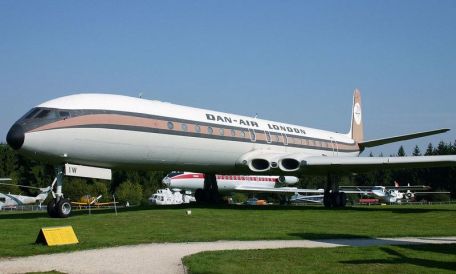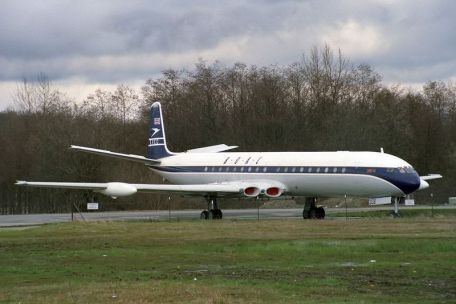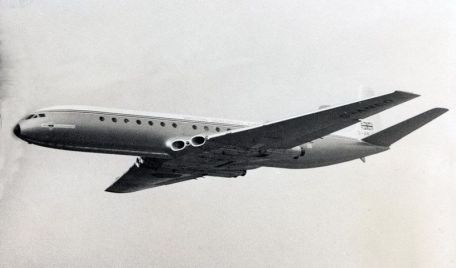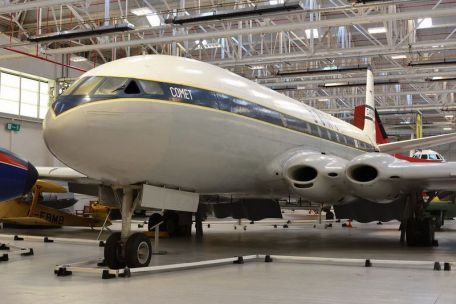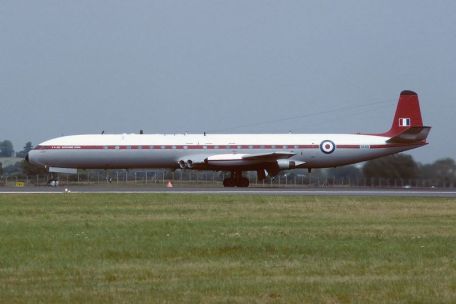De Havilland DH. History of Comet 106
De Havilland DH. The 106 Comet holds the distinction of being the world's first commercial airliner to market. The design stems from work begun in 1943 during World War II (1939-1945) and looks at the future of passenger air travel in the UK.
Including the prototype used in the test flight phase of the project, a total of 114 Comets have been completed, with major customers being British Royal Airways, British European Airways, Dan Air and the Royal Air Force (RAF). The last copy was decommissioned on March 14, 1997.
The first flight in prototype form was recorded on July 27, 1949.
Comet enjoyed early success and high-profile publicity that gave Britain a head start in the passenger jet market, but the series ended with an equally high-profile crash and accident. This period eventually allowed American rivals to take over with their own famous designs.
For the British, the Comet influenced another major Cold War player, the Hawke Siddeley "Nimrod" in the late 1960s (detailed elsewhere on this page), as 49 of them were for the RAF Built to meet maritime patrol standards.
Comet Evolution
Various forms of what would become DH were developed during the design research phase of Comet. 106 appeared, including a version with two tail booms, one with a canard front wing, and one without a horizontal tail, while relying on a large area swept wing main aircraft.
Many of these early products were influenced by the "blank canvas" of the prospect of jet-powered flight during World War II. However, as the decade progressed, the Comet's design began to materialize along a more traditional route - giving us the tried-and-true jet shape still in use today.
Journey to the Comet
The tubular fuselage was designed to act as the focal point of the aircraft, with a short nose cone giving the pilot a good view of the front section. The passenger area takes up most of the interior space of the tubes, which taper at the rear end to form the rear wing. The rear wing consists of a circular vertical rear wing complemented by a low overhanging horizontal plane. The main wing planes are also set low, about the middle of the boat, and the leading edges of the wings are swept back.
Within each wing root are pairs of turbojets, which are drawn in through ports on the leading edge of the wing and discharged through ports beyond the trailing edge. Their placement within the wings allows the plane to maintain considerable aerodynamic efficiency through its basic streamlined shape.
For ground operation, fully retractable multi-wheeled undercarriage elements were used.
Comet variant
There are four notable production variants in the Comet series, referred to simply as "Comet 1", "Comet 2", "Comet 3" and "Comet 4". The original 40-seat Comet One originated from the production of a dozen airframes and featured square windows, and the overall appearance was largely based on the original de Havilland prototype.
By this time, however, the design had incorporated multi-bogie main landing gear elements over the original single-wheel form. The original model was equipped with 4 x Ghost 50 Mk 1 series turbojets, but these engines gave way to 4 x Ghost FGT3 series engines.
The first model spawned the Comet 1A, which improved performance and allowed for greater take-off weight, speed and range. Ten examples follow the standard. The Royal Canadian Air Force (RCAF) received a pair of Comet 1 models with reinforced skins and operating under the name Comet 1X.
The successor, the Comet 1XB Standard, was the Comet 1A, which had a reinforced fuselage base and more rounded windows.
The Comet 1 Series has a top speed of 460 mph, a maximum takeoff weight of 110,000 pounds, a range of up to 1,500 miles, and a cruising altitude of 42,000 feet. With these specs, it clearly surpassed the propeller-powered developments of the time and was of great interest to a flight-hungry audience.
Comet 2 received an improved wing main aircraft with a larger surface area and switched to more powerful Rolls-Royce 'Avon' turbojets to better suit the proposed Atlantic/surface route. This also increases the operating range, but not to the extent required for this type of sailing.
This variant is about a meter longer than the original Comet 1 and differs from the later Comet 1 branded round windows. The original Comet 2 flew for the first time on August 27, 1953, followed by delivery in 1955.
Other variants include a one-off Comet 2X development model (with RR Avon 502 turbojets), a pair of Comet 2E aircraft (hybrid RR Avon 504/Avon 524 turbojets), a pair of Comet T2 branded (as the RAF's crew trainers), eight RAF Comet 2C platforms and three Comet 2R development platforms.
The Comet 1 and Comet 2 brands can carry 36 and 44 passengers respectively. The Comet 2 has a top speed of 490 mph, an MTOW of 120,000 pounds, a range of up to 2,600 miles, and a cruising altitude of 42,000 feet.
Comet 3 was first released in 1954 and was the next logical branch of the series. It was more than 15 feet longer than the earlier Comet 2 and was powered by 4 more powerful RR Avon M502 turbojets. This of course resulted in the brand having better range and overall performance compared to previous Comet brands, but only two Comet 3 airframes were built.
These characters in the comet's history have largely lived developmental lives, with the other nine airframes still unfinished. The related Comet 3B used a reduced wingspan main aircraft, and the model flew publicly at Farnborough in 1958.
The Comet 3 is designed to carry between 58 and 76 passengers. It has a top speed of 520 mph, a maximum takeoff weight of 150,000 pounds, a range of up to 2,700 miles, and a cruising altitude of 45,000 feet.
The Comet 4 continues the path of the Comet 3 series with further increased fuel capacity for better range and improvements in performance, take-off weight and interior seating capacity. The first deliveries of the brand began in September 1958, with 18 aircraft delivered to the carrier BOAC. Another 23 were produced under the Comet 4C designation, with Comet 4 standard wings and Comet 4B fuselage.
Two prototypes were forged from work at Comet 4C serving the most important Hawker Siddeley "Nimrod" project detailed elsewhere on this page.
The Comet 4 can carry between 56 and 81 passengers. It has a top speed of 520 mph, a maximum takeoff weight of 156,000 pounds, a range of up to 3,225 miles, and a cruising altitude of 42,000 ft miles.
The Comet 5 brand is an improved version of the Comet series with a wider fuselage for increased seating, an improved wing main aircraft with greater sweep and more efficient Rolls-Royce "Conway" turbofan engines onboard Wing Nacelles / Pods This design fell into nothingness.
Comet Bomber
As early as 1946, the British Department of Aeronautics developed specification B.35/46, which required a nuclear-capable high-altitude reconnaissance platform and DH. 106 was briefly introduced in DH. 111 "Comet Bomber" outfit.
The design appeared in 1948, but was shelved due to the support of the V-bomber force, which controlled Britain's nuclear arsenal for the foreseeable future.
Operators and Service Occupations
The comet has operators all over the world, from Argentina and Australia to Sudan and the United Kingdom. The British and Canadians also operated the platform at the military level, which put the airframe through harsh defense-oriented service during the Cold War (1947-1991).
Of the former, Comet C2, Comet 2R, and Comet C4 were all brands used from 1956 to 1975. Of the latter, the Comet 1A was the preferred stand, although the fleet was later upgraded to the Comet 1XB as standard. RCAF operated their comet from 1953 to 1963.
Comet operations have been affected by accidents and fatalities, including 13 crashes and 426 fatalities. From May 1953 to April 1954 alone, there were three high-profile crashes that grounded the entire fleet pending review.
This time was then used to make changes to the design, and the series was not allowed to fly again until 1958. Weak operations have given U.S. rivals Boeing and Douglas time to focus on leading the U.K. in the jetliner market.
De Havilland DH. 106 Comet Specification
Basic
Production
Roles
- Commercial Market
Dimensions
91.86 ft (28 m)
114. 83 feet (35 m)
29.53 ft (9 m)
Weight
50,000 kg
Performance
Performance
466 mph (750 km/h; 405 knots)
42,651 ft (13,000 m; 8.08 mi)
1,491 miles (2,400 km; 1,296 nautical miles)
Armor
No.
Changes
Comet - Base Series Name
Comet 1 - first production model; square window openings; 4 x Ghost 50 Mk 1 turbojets; 40 passenger seats.
Comet 1A - increased weight and range operation; introduced water-ethanol injection for engine; ten examples completed.
Comet 1X - Pairing for RCAF operations; fortified skin.
Comet 1XB - Four Comet 1A models conforming to the Comet 1XB standard; round windows.
Comet 2 - second production model
Comet 2X - One-off model with 4 x Rolls-Royce Avon 502 turbojets; development variant.
Comet 2E - A pair of Comet 2 aircraft, powered by hybrid Avon 504/524 engines.
Comet T2 - RAF aircrew trainer based on the Comet 2.
Comet C2 - RAF aircraft
Comet 2R - Three aircraft for RAF radar/electronics development.
Comet 3 - The third limited series model
Comet 3B - Reduced wingspan
Comet 4 - Final production form; improved Comet 3; increased fuel capacity with more passenger seats, increased MTOW and better overall performance; Avon turbojet.
Comet 4B - Capital Airlines model; due to lengthened fuselage, reduced wingspan and increased internal capacity.
Comet 4C - Comet 4 wing assembly and Comet 4B extended fuselage.
Comet 5 - Proposed version with wider fuselage and larger swept modified wings; powered by Rolls-Royce Conway series jet engines in pods; not built.
DH.
Enter HS. 801 ("Sea Comet") - Prototype in service with the Royal Air Force's Hocknimrod Maritime Patrol Platform programme.



